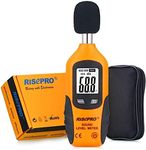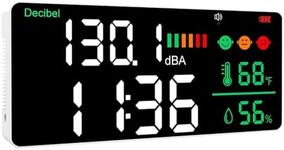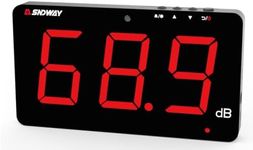We Use CookiesWe use cookies to enhance the security, performance,
functionality and for analytical and promotional activities. By continuing to browse this site you
are agreeing to our privacy policy
10 Best Noise Level Meters 2025 in the United States
From leading brands and best sellers available on the web.How do we rank products for you?
Our technology thoroughly searches through the online shopping world, reviewing hundreds of sites. We then process and analyze this information, updating in real-time to bring you the latest top-rated products. This way, you always get the best and most current options available.

Buying Guide for the Best Noise Level Meters
Choosing the right noise level meter can be crucial for various applications, whether you're monitoring workplace noise, ensuring compliance with regulations, or simply measuring sound levels in your environment. To make an informed decision, it's important to understand the key specifications and how they align with your specific needs. Here are the main factors to consider when selecting a noise level meter.AccuracyAccuracy refers to how close the measurements of the noise level meter are to the actual sound levels. This is important because precise measurements are crucial for compliance with safety standards and regulations. Accuracy is usually expressed in decibels (dB), with a lower number indicating higher accuracy. For professional use, such as in industrial settings or for regulatory compliance, look for meters with an accuracy of ±1 dB or better. For general use, an accuracy of ±2 dB may be sufficient.
Frequency RangeThe frequency range indicates the range of sound frequencies that the meter can accurately measure, typically expressed in Hertz (Hz). This is important because different environments and applications may involve different frequency ranges. For example, human speech typically falls between 300 Hz and 3,400 Hz, while industrial noise can cover a much broader range. If you need to measure a wide variety of sounds, choose a meter with a broad frequency range, such as 20 Hz to 20 kHz. For more specific applications, ensure the meter covers the relevant frequencies.
Dynamic RangeDynamic range refers to the range of sound levels that the meter can measure, from the quietest to the loudest sounds. This is important for capturing the full spectrum of noise in your environment. The dynamic range is usually expressed in decibels (dB). For general use, a dynamic range of 30 dB to 130 dB is often sufficient. For more specialized applications, such as measuring very quiet or very loud environments, look for meters with a wider dynamic range.
Weighting FiltersWeighting filters (such as A, C, and Z weighting) adjust the meter's sensitivity to different frequencies to mimic human hearing or to meet specific standards. This is important because different applications may require different weighting. A-weighting is commonly used for general noise measurements as it approximates human hearing sensitivity. C-weighting is used for measuring peak levels and low-frequency noise. Z-weighting is a flat response across the frequency range. Choose the weighting filter that aligns with your measurement needs.
Data Logging and StorageData logging and storage capabilities allow the meter to record and store measurements over time. This is important for tracking noise levels, identifying trends, and maintaining records for compliance purposes. Some meters offer internal memory, while others support external storage options like SD cards. If you need to monitor noise levels over extended periods or need detailed records, choose a meter with robust data logging and storage features.
Display and InterfaceThe display and interface of the noise level meter determine how easy it is to read and interpret the measurements. This is important for ensuring that you can quickly and accurately assess noise levels. Look for meters with clear, backlit displays that show all relevant information at a glance. An intuitive interface with easy-to-navigate menus can also enhance usability, especially in field conditions.
CalibrationCalibration ensures that the noise level meter provides accurate measurements over time. This is important for maintaining the reliability of your data. Some meters come with a built-in calibration feature, while others require an external calibrator. Regular calibration is essential, especially for professional and regulatory applications. Choose a meter that offers easy and reliable calibration options.
Most Popular Categories Right Now
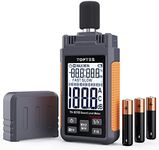



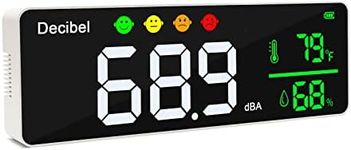

![[Rechargeable 3IN1 Decibel Meter] WESTOBIG Sound Level Meter, Digital dB Meter Noise Meter 30dB to 130dB Portable SPL Meter MAX Data Hold with Color Display Backlight](https://images-proxy.bestreviews.guide/SaV5l_BPsJ4wrDP8K-HgNfqwHN0=/0x150/https://m.media-amazon.com/images/I/41EPu2UuIQL._AC_CX679_.jpg)
